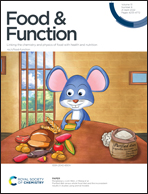Bioaccessibility, gut microbial metabolism and intestinal transport of phenolics from 100% Concord grape juice and whole grapes are similar in a simulated digestion and fecal fermentation model†
Abstract
Phenolic rich 100% grape juice has been associated with many health benefits, but its place in dietary guidance is controversial relative to whole fruit. Direct comparisons of phenolic profiles and bioavailability between these food forms are needed. Phenolic bioaccessibility and metabolism from Concord (CG) and Niagara (NG) grapes and corresponding 100% juices were investigated using an in vitro digestion coupled with anaerobic gut fermentation model. Intestinal transport of resulting bioaccessible phenolics and microbial metabolites was estimated using a Caco-2 cell model. Total bioaccessible phenolics from both upper and lower digestion were similar (P > 0.05) between NG (400.9 ± 26.3 μmol per 100 g) and NGJ (349.5 ± 8.3 μmol per 100 g) and significantly different (P < 0.05) between CG (417.2 ± 24.4 μmol per 100 g) and CGJ (294.3 ± 45.4 μmol per 100 g) total cellular transport of phenolics was similar (P > 0.05) between whole grapes (89.4 ± 5.3 μmol per 100 g for CG, and 71.8 ± 2.4 μmol per 100 g for NG) and 100% juices (88.0 ± 5.6 μmol per 100 g for CGJ, and 85.3 ± 9.4 μmol per 100 g for NGJ). Differences were observed between the location of phenolic metabolism, bioaccessibility and subsequent cellular transport of individual phenolics between grapes and juice matrices. Specifically, greater amounts of phenolics were transported from grape juices than whole grapes from the upper tract. However, cumulative bioaccessibility and transport from upper and lower GI digestion/fermentation together indicates that the absorbable phenolics from 100% grape juice is similar to that of whole grapes, suggesting that phenolic-mediated health benefits from consumption of whole fruit and juice may be similar.

- This article is part of the themed collection: Food & Function HOT Articles 2022


 Please wait while we load your content...
Please wait while we load your content...